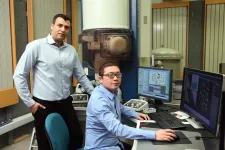(Press-News.org) In a surprising discovery, Princeton physicists have observed an unexpected quantum behavior in an insulator made from a material called tungsten ditelluride. This phenomenon, known as quantum oscillation, is typically observed in metals rather than insulators, and its discovery offers new insights into our understanding of the quantum world. The findings also hint at the existence of an entirely new type of quantum particle.
The discovery challenges a long-held distinction between metals and insulators, because in the established quantum theory of materials, insulators were not thought to be able to experience quantum oscillations.
"If our interpretations are correct, we are seeing a fundamentally new form of quantum matter," said Sanfeng Wu, assistant professor of physics at Princeton University and the senior author of a recent paper in Nature detailing this new discovery. "We are now imagining a wholly new quantum world hidden in insulators. It's possible that we simply missed identifying them over the last several decades."
The observation of quantum oscillations has long been considered a hallmark of the difference between metals and insulators. In metals, electrons are highly mobile, and resistivity -- the resistance to electrical conduction -- is weak. Nearly a century ago, researchers observed that a magnetic field, coupled with very low temperatures, can cause electrons to shift from a "classical" state to a quantum state, causing oscillations in the metal's resistivity. In insulators, by contrast, electrons cannot move and the materials have very high resistivity, so quantum oscillations of this sort are not expected to occur, no matter the strength of magnetic field applied.
The discovery was made when the researchers were studying a material called tungsten ditelluride, which they made into a two-dimensional material. They prepared the material by using standard scotch tape to increasingly exfoliate, or "shave," the layers down to what is called a monolayer -- a single atom-thin layer. Thick tungsten ditelluride behaves like a metal. But once it is converted to a monolayer, it becomes a very strong insulator.
"This material has a lot of special quantum properties," Wu said.
The researchers then set about measuring the resistivity of the monolayer tungsten ditelluride under magnetic fields. To their surprise, the resistivity of the insulator, despite being quite large, began to oscillate as the magnetic field was increased, indicating the shift into a quantum state. In effect, the material -- a very strong insulator -- was exhibiting the most remarkable quantum property of a metal.
"This came as a complete surprise," Wu said. "We asked ourselves, 'What's going on here?' We don't fully understand it yet."
Wu noted that there are no current theories to explain this phenomenon.
Nonetheless, Wu and his colleagues have put forward a provocative hypothesis -- a form of quantum matter that is neutrally charged. "Because of very strong interactions, the electrons are organizing themselves to produce this new kind of quantum matter," Wu said.
But it is ultimately no longer the electrons that are oscillating, said Wu. Instead, the researchers believe that new particles, which they have dubbed "neutral fermions," are born out of these strongly interacting electrons and are responsible for creating this highly remarkable quantum effect.
Fermions are a category of quantum particles that include electrons. In quantum materials, charged fermions can be negatively charged electrons or positively charged "holes" that are responsible for the electrical conduction. Namely, if the material is an electrical insulator, these charged fermions can't move freely. However, particles that are neutral -- that is, neither negatively nor positively charged -- are theoretically possible to be present and mobile in an insulator.
"Our experimental results conflict with all existing theories based on charged fermions," said Pengjie Wang, co-first author on the paper and postdoctoral research associate, "but could be explained in the presence of charge-neutral fermions."
The Princeton team plans further investigation into the quantum properties of tungsten ditelluride. They are particularly interested in discovering whether their hypothesis -- about the existence of a new quantum particle -- is valid.
"This is only the starting point," Wu said. "If we're correct, future researchers will find other insulators with this surprising quantum property."
Despite the newness of the research and the tentative interpretation of the results, Wu speculated about how this phenomenon could be put to practical use.
"It's possible that neutral fermions could be used in the future for encoding information that would be useful in quantum computing," he said. "In the meantime, though, we're still in the very early stages of understanding quantum phenomena like this, so fundamental discoveries have to be made."
INFORMATION:
In addition to Wu and Wang, the team included co-first authors Guo Yu, a graduate student in electrical engineering, and Yanyu Jia, a graduate student in physics. Other key Princeton contributors were Leslie Schoop, assistant professor of chemistry; Robert Cava, the Russell Wellman Moore Professor of Chemistry; Michael Onyszczak, a physics graduate student; and three former postdoctoral research associates: Shiming Lei, Sebastian Klemenz and F. Alexandre Cevallos, who is also a 2018 Princeton Ph.D. alumnus. Kenji Watanabe and Takashi Taniguchi of the National Institute for Material Science in Japan also contributed.
"Landau quantization and highly mobile fermions in an insulator," by Pengjie Wang, Guo Yu, Yanyu Jia, Michael Onyszczak, F. Alexandre Cevallos, Shiming Lei, Sebastian Klemenz, Kenji Watanabe, Takashi Taniguchi, Robert J. Cava, Leslie M. Schoop, and Sanfeng Wu, was published Jan. 4 in the journal Nature (DOI: 10.1038/s41586-020-03084-9).
This work was primarily supported by the National Science Foundation (NSF) through the Princeton University Materials Research Science and Engineering Center (DMR-1420541 and DMR-2011750) and a CAREER award (DMR-1942942). Early measurements were performed at the National High Magnetic Field Laboratory, which is supported by an NSF Cooperative Agreement (DMR-1644779), and the State of Florida. Additional support came from the Elemental Strategy Initiative conducted by the Ministry of Education, Culture, Sports, Science and Technology of Japan (JPMXP0112101001), the Japan Society for the Promotion of Science's KAKENHI program (JP20H00354) and the Japan Science and Technology Agency's CREST program (JPMJCR15F3). Further support came from the U.S. Army Research Office Multidisciplinary University Research Initiative on Topological Insulators (W911NF1210461), the Arnold and Mabel Beckman Foundation through a Beckman Young Investigator grant, and the Gordon and Betty Moore Foundation (GBMF9064).
Reston, Virginia--Physicians who follow artificial intelligence (AI) advice may be considered less liable for medical malpractice than is commonly thought, according to a new study of potential jury candidates in the U.S. Published in the January issue of The Journal of Nuclear Medicine (JNM). The study provides the first data related to physicians' potential liability for using AI in personalized medicine, which can often deviate from standard care.
"New AI tools can assist physicians in treatment recommendations and diagnostics, including the interpretation of medical images," remarked Kevin Tobia, JD, PhD, ...
TORONTO, ON - New research led by researchers at the University of Toronto (U of T) and Northwestern University employs machine learning to craft the best building blocks in the assembly of framework materials for use in a targeted application.
The findings, published today in Nature Machine Intelligence, demonstrated that the use of artificial intelligence (AI) approaches can help in proposing novel materials for diverse applications. One example is the separation of carbon dioxide from industrial combustion processes. AI approaches promise the acceleration of the design cycle for materials.
With the objective of improving the separation of chemicals in industrial processes, the team of researchers - including collaborators from ...
'This effort truly represents a "moonshot" in COVID-19 research'
Scientists identify target to treat COVID pneumonia and reduce severity
Clinical trials with new experimental drug to begin early in 2021
Goal is to develop treatments that make COVID-19 no worse than a common cold
First comparison between immune mechanisms driving COVID-19 pneumonia with other pneumonias
CHICAGO --- Bacteria or viruses like influenza that cause pneumonia can spread across large regions of the lung over the course of hours. In the modern intensive care unit, these bacteria or viruses are usually controlled either by antibiotics or by the body's immune system within ...
How are networks of neurons connected to make functional circuits? This has been a long standing question in neuroscience. To answer this fundamental question, researchers from Boston Children's Hospital and Harvard Medical School developed a new way to study these circuits and in the process learn more about the connections between them.
"Neural networks are extensive, but the connections between them are really small," says Wei-Chung Allen Lee, PhD, of the F.M. Kirby Neurobiology Center at Boston Children's and Harvard Medical School. "So, we have had to develop techniques to see them in extremely high-resolution over really large areas and volumes." ...
ORLANDO, Jan. 11, 2021 - Data from Arecibo Observatory in Puerto Rico has been used to help detect the first possible hints of low-frequency disturbances in the curvature of space-time.
The results were presented today at the 237th meeting of the American Astronomical Society, which was held virtually, and are published in The Astrophysical Journal Letters. Arecibo Observatory is managed by the University of Central Florida for the National Science Foundation under a cooperative agreement.
The disturbances are known as gravitational waves, which ripple through space as a result of the movement of incredibly massive objects, such as black holes orbiting one another or the collision of neutron stars.
It's important to understand these waves as they provide insight into the history ...
CAMBRIDGE, MA -- When we experience a new event, our brain records a memory of not only what happened, but also the context, including the time and location of the event. A new study from MIT neuroscientists sheds light on how the timing of a memory is encoded in the hippocampus, and suggests that time and space are encoded separately.
In a study of mice, the researchers identified a hippocampal circuit that the animals used to store information about the timing of when they should turn left or right in a maze. When this circuit was blocked, the mice were unable to remember which way they were supposed to turn next. However, disrupting the circuit ...
North Carolina State University-led researchers have developed an analytical measurement "framework" which could allow organic solar cell researchers and manufacturers to determine which materials will produce the most stable solar cells prior to manufacture.
Organic solar cells have increased in efficiency over the past decades, but researchers and manufacturers still struggle with determining which material combinations work best and why, as well as with achieving stable morphology and operation.
"There is still a lot of 'trial and error' guesswork involved in identifying promising materials for these solar cells," says Harald Ade, Goodnight Innovation Distinguished Professor of Physics at NC State and co-corresponding author of the research. ...
Two studies in today's Nature Neuroscience, led by researchers at Boston Children's Hospital, Brigham and Women's Hospital (BWH), and Harvard Medical School (HMS), implicate mosaic mutations arising during embryonic development as a cause of autism spectrum disorder (ASD). The findings open new areas for exploring the genetics of ASD and could eventually inform diagnostic testing.
Mosaic mutations affect only a portion of a person's cells. Rather than being inherited, they arise as a "mistake" introduced when a stem cell divides. A mutation in a stem cell will only be passed to the cells that descend from it, producing the mosaic pattern. ...
Reza Shahbazian-Yassar, professor of mechanical and industrial engineering at the University of Illinois Chicago.
Shahbazian-Yassar and colleagues facilitated the development of a cutting edge "Swiss Army knife" catalyst made up of 10 different elements - each of which on its own has the ability to reduce the combustion temperature of methane - plus oxygen. This unique catalyst can bring the combustion temperature of methane down by about half - from above 1400 degrees Kelvin down to 600 to 700 degrees Kelvin.
Their findings are reported in the journal Nature Catalysis.
In previously-published research, ...
Tales of post-apocalyptic landscapes in which few survivors emerge into a new and much different world have long been popular tales woven by screenwriters and authors. While many enjoy these stories, thinking of them as nothing but a guilty pleasure, they may not realize that immersing themselves in fiction has prepared them for the reality of 2020, according to a team of researchers.
John Johnson, professor emeritus of psychology at Penn State, recently conducted research with several colleagues revealing that an individual's enjoyment of horror films could have better prepared them for the COVID-19 pandemic as opposed to others who do not enjoy frightening entertainment. Their findings are documented in Personality and Individual Differences.
"My latest ...



